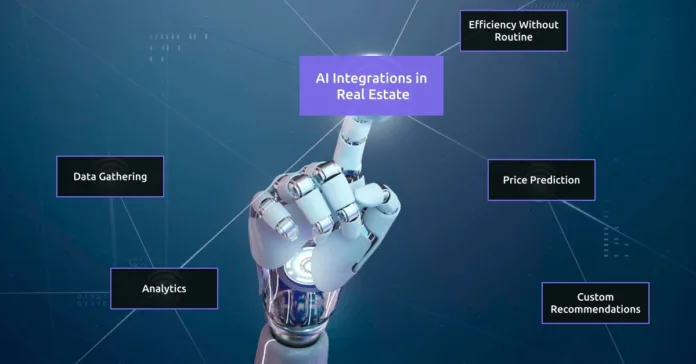
Machine learning, a branch of Artificial Intelligence (AI), uses algorithms and technologies to extract valuable insights from large datasets. The limitations imposed by the global pandemic have unexpectedly influenced traditional real estate processes for the better. Thousands of businesses, including realtors, appraisers, mortgage lenders, and others, were forced to incorporate rapidly emerging PropTech solutions to adapt to the crisis. Real estate AI applications are now capable of managing predetermined data flows, learning user behavior, streamlining operations, and providing more accurate assessments and market forecasts in the short term. Homeowners, potential renters, and buyers are increasingly embracing these tools, and investors recognize real estate as the world’s most valuable asset class.
Despite several attempts to integrate AI and machine learning into real estate, challenges remain, particularly regarding data accuracy and job displacement within the sector. This project aims to improve the precision of AI-driven insights while providing a secure platform for real estate agents. It ensures a safer way for users to analyze their requirements and protects them from fraudulent data. By integrating multiple modules, the project seeks to enhance both accuracy and customer satisfaction, ultimately elevating the real estate experience and making it safer and more efficient for all involved.
PROPOSED SYSTEM
In Fig 1., we show the detailed system architecture of Artificial Intelligence in Real Estate. The presented system will be a website in which algorithms can go through millions of documents in seconds looking through property values, location, home renovations, and even some of a homeowner’s personal information. With this hybrid approach of using multiple algorithms as well as regressions, much more accurate data is achieved. The web system supports the buyers as well as the estate agents which ensures there is no loss of human resources and jobs. Investors or buyers have their own unique needs which they can give as inputs to the portal, after which the requirements are compared with the database as well as estate agent inputs to determine the most suitable property. To keep the model efficient feature engineering.

Has been used along with AI and ML. Inputs such as bedroom, hall, kitchen, bathroom, square foot, etc are considered as features that are then searched in the data storage. After finding the appropriate and cleaned data multiple algorithms are used such as Decision Tree Regression, Random Forest Regression, XGBoost Regressor, and MLP Neural Network. On receiving the output or results the accuracy is evaluated and compared to find the best possible result, once the evaluation is complete most accurate data is provided to the buyer. Various modules have been integrated to improve accuracy drastically. The modules of this web based portal are as follows:
A. Requirement/ Feature Input
Initially the buyers are required to fill in the required aspects that the property should have. Since feature engineering is used the buyer can be more specific about their needs which can be location, history, facilities, etc.
B. Data searching and processing
The input features are analyzed and searched within the database for updates or availability. After the data has been parsed it is sent further to undergo multiple regressions and algorithms are applied. As shown in Fig.2, we can see the mechanism of how the user gets the property detail.

C. Evaluation and Comparison
Once all the results have been found, the output from each algorithm is compared to check the accuracy and mean absolute error to evaluate the most appropriate data. Since the amount of feature input is more, hence various methods have been used to give better results. Additionally various methods can also be integrated which even further increases the accuracy.
RESULT AND DISCUSSION
The proposed system gives all the features provided by the traditional existing systems but instead of working only with non-spatial databases, the system also works with spatial data. The following prominent features will be included in the system: Specification-based searching. This feature displays relevant information to users based on the specifications they have provided to the website. The System will allow the user to search for a property quickly and easily forbuying and selling. The registered user can list his or her property for sale or rent. This system safeguards customers as well as brokers from false advertisements and data.



CONCLUSION
After researching the use of AI in real estate, we found that Skyline AI is the dominant technology in the sector, leading to a significant reduction in the role of brokers and agents, which is one of the key downsides of AI adoption. This project aims to address this challenge by improving price prediction accuracy using both traditional and advanced machine learning algorithms on real-time data, and incorporating fraud detection through analysis of days-on-the-market. Additionally, the project provides a platform for brokers and agents to post updated property prices, allowing customers to select the most suitable and profitable options.
As the real estate industry rapidly digitizes, AI has become an essential tool. AI algorithms can help agents identify market opportunities and secure more clients through predictive models, while also assisting clients in predicting the best times to buy or sell property. Ultimately, AI enables a self-driving dimension for real estate transactions, handling complex tasks like data analysis, compliance, paperwork, property searches, negotiations, and offers, simplifying the entire process.
About the author
The author is the Managing Director at Skanda Group of Constructions. He is an experienced Civil Engineer with a demonstrated history of working in the construction industry. He is skilled in AutoCAD, Construction, Management, Concrete, and Structural Analysis.



